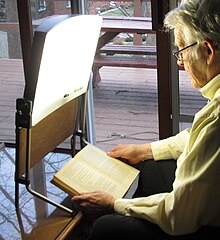User:Mr. Ibrahem/Seasonal affective disorder
| Seasonal affective disorder | |
|---|---|
| Other names | Depressive disorder with seasonal pattern, winter depression, winter blues, summer depression, seasonal depression[1] |
 | |
| Bright light therapy is a common treatment for seasonal affective disorder and for circadian rhythm sleep disorders. | |
| Specialty | Psychiatry |
| Symptoms | Depressive during a specific time of the year[2] |
| Duration | Recurrent[2] |
| Causes | Unclear[2] |
| Risk factors | Family history[3] |
| Diagnostic method | Based on symptoms[2] |
| Differential diagnosis | Cyclothymia, major depression, bipolar, premenstrual dysphoric disorder, chronic fatigue syndrome, low thyroid[4] |
| Treatment | Light therapy, counselling, antidepressants, vitamin D[2] |
| Frequency | ~5% (US)[4] |
Seasonal affective disorder (SAD) is a mood disorder in which people develop depressive during a specific period of the year.[2] This occurs recurrently, and most commonly during the winter.[2] Symptoms may include feeling low, lacking interest in activities that were once enjoyed, trouble sleeping, changes in appetite, trouble concentrating, and having little energy.[2]
The cause is unclear.[2] Risk factors include family history.[3] In the DSM-5, it is not a unique disorder, but applied as the specifier "with seasonal pattern" to major depressive disorder or bipolar disorder.[5][3] Diagnosis is based on symptoms.[2]
Treatment may include light therapy, counselling, antidepressants, or vitamin D.[2] Increasing exercise is also recommended.[3] As symptoms begin predictably during a specific time of the year, treatment may be started before symptoms are expected to begin.[2] Symptoms often improve 1 to 2 weeks after starting treatment.[4]
SAD is estimated to affected 5% of people in the United States.[4] Rates vary with latitude from 1.4% in Florida to 10% in Alaska.[6] Women are affected four times more frequently than men.[2][4] Onset is often in early adulthood.[2] The condition was formally described and named by Norman E. Rosenthal in 1984.[7][8][1]
References[edit]
- ^ a b Danilenko, KV; Levitan, RD (2012). "Seasonal affective disorder". Handbook of clinical neurology. 106: 279–89. doi:10.1016/B978-0-444-52002-9.00017-6. PMID 22608628.
- ^ a b c d e f g h i j k l m n "NIMH » Seasonal Affective Disorder". www.nimh.nih.gov. Retrieved February 16, 2021.
- ^ a b c d Galima, SV; Vogel, SR; Kowalski, AW (December 1, 2020). "Seasonal Affective Disorder: Common Questions and Answers". American family physician. 102 (11): 668–672. PMID 33252911.
- ^ a b c d e Kurlansik, SL; Ibay, AD (December 1, 2012). "Seasonal affective disorder". American family physician. 86 (11): 1037–41. PMID 23198671.
- ^ American Psychiatric Association (2013). Diagnostic and Statistical Manual of Mental Disorders (Fifth ed.). Arlington, VA: American Psychiatric Publishing. pp. 187. ISBN 978-0-89042-555-8.
- ^ Nolen-Hoeksema, Susan (2014). Abnormal Psychology (6th ed.). New York, New York: McGraw-Hill Education. p. 179. ISBN 978-1-259-06072-4.
- ^ Rosenthal NE, Sack DA, Gillin JC, Lewy AJ, Goodwin FK, Davenport Y, Mueller PS, Newsome DA, Wehr TA (January 1984). "Seasonal affective disorder. A description of the syndrome and preliminary findings with light therapy". Archives of General Psychiatry. 41 (1): 72–80. doi:10.1001/archpsyc.1984.01790120076010. PMC 2686645. PMID 6581756.
- ^ Itkowitz, Colby. "The Washington Post helped discover seasonal affective disorder. Now here's how to beat it". Washington Post. Retrieved February 17, 2021.
